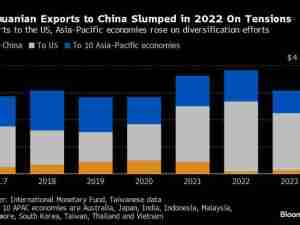Southern European economies that were long sneered at by their richer northern neighbors have turned the tables as they cement their role as growth drivers in the sputtering euro area.
Business surveys by S&P Global released this week showed Spain and Italy beat economists’ expectations with faster expansion in March. A manufacturing gauge for Greece indicated a similar trend. This helped the index for the currency bloc emerge from contraction for the first time in 10 months.
“Spain and Italy provided the greatest boosts, with their growth rates accelerating to the strongest for nearly a year,” Hamburg Commercial Bank said. This helped offset sustained contractions in output in Germany and France that began in mid-2023.
A tourism surge since the pandemic, booming exports, and lower energy prices thanks to renewables and limited reliance on Russian gas, have given so-called periphery countries on the Mediterranean the edge in the euro area.

After the pandemic “tourism is doing very well in the European south,” Bank of Greece Governor Yannis Stournaras said Saturday at a conference in Athens.
But the region’s relatively strong growth is mainly due to the fact that after many years, southern European countries have “corrected their imbalances, so now they are developing at a healthy rate without macroeconomic imbalances,” Stournaras said.
Just over a decade ago, these same countries — looked down upon as spendthrift and less productive — were at the core of a debt crisis that called into question the currency’s very survival.
This year, Spain, Portugal and Greece are expected to be among the top performing economies in the 20-nation bloc, according to the European Commission.
By contrast, the French government has just lowered its 2024 growth forecast and reported a budget deficit far exceeding its estimate for 2023, prompting it to seek tens of billions of euros of spending cuts. Germany is likely at the tail end of a shallow recession, weighed down by hesitant consumers, weak external demand and high borrowing costs.
Investors including Vanguard Asset Management, JPMorgan Asset Management and Neuberger Berman have been buying up the government bonds of southern European countries, taking advantage of a rally that’s sharply narrowed the premium over Germany and France.
The spread between 10-year Portuguese bonds and bunds, for example, has roughly halved to about 65 basis points since a mid-2022 peak.
Spain’s economy in particular has stood out from the pack as it has seen a boom in exports of everything from financial services to manufacturing that has accelerated since the Covid crisis.
“It won’t be a new Eldorado, but it’s a country that will continue to attract investors,” Natixis economist Jesus Castillo told Bloomberg.
In addition to benefiting from less exposure to fossil fuel price rises, he said Spain could have “lasting advantages” that include lower labor costs than in France, Germany and Italy, a skilled workforce and a well-functioning healthcare system. He also said the country is set to benefit from businesses reshoring production.
Domestic demand remains strong, too, with consumers and corporations having cut debt levels to the lowest since before the 2008-2012 crisis, and the unemployment rate hovering around the lowest since 2007.
“We strongly like Spain,” said Ales Koutny, head of international rates at Vanguard. “We think the fundamentals there continue to be not fairly priced by the market. Everything is looking great in Spain but still long-term — especially with the data that we had recently from France — we can see that there’s a lot of room for compression between Spain and France.”
The spread between Spanish and French 10-year bond yields has more than halved since a peak in mid-2022 to just above 30 basis points.
In neighboring Portugal, tourism brought in record revenue of €25 billion ($27.2 billion) in 2023, up from €21 billion the previous year, according to the government. The country has also seen a steady increase in exports, which have traditionally included textiles, as well as car and automobile parts. Since 2019, it has been Europe’s biggest bike manufacturer.
It has also become a property hotspot for foreign buyers. Wealthy investors have been snapping up commercial buildings, as well as hotels and residential real estate in recent years.
With a recovery in rainfall and plenty of wind turbines, Portugal has also been able to reduce the need to use gas to generate power. Last year, wind energy met 25% of total electricity demand and hydropower 23%, while gas-fired plants represented 19%.
Weaning itself off gas has been a particular challenge for Germany, which had become used to powering its heavy industries with cheap imports from Russia in the decades before the invasion of Ukraine and the ensuing energy crisis.
Greece, which won back its investment grade status late last year, has seen tourism break record levels every year since the pandemic. The sector accounts for around a quarter of the economy and it generated 15.7% more revenue in 2023.
Construction is also a large growth driver, with almost 56% more building permits issued last year than in 2019.
In another sign that Greece has put its debt woes behind it, the sale of a 30% stake in Athens International Airport two months ago marked its biggest initial public offering in more than two decades.





